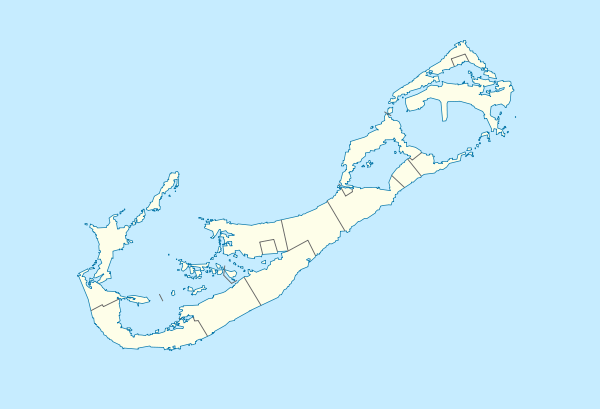RNAS Boaz Island (HMS Malabar)
RNAS Bermuda (HMS Malabar) was a Royal Naval Air Station on Boaz Island (and also the cojoined Watford Island), Bermuda. The station became the primary base for the Royal Navy in the North-West Atlantic following American independence. It was the location of a dockyard, an Admiralty House, and the base of a naval squadron.
| RNAS Bermuda or Boaz Island (HMS Malabar) | |
|---|---|
 The surviving hangar at the former HMS Malabar, the Fleet Air Arm's Royal Naval Air Station on Boaz Island | |
 RNAS Boaz Island Shown within Bermuda | |
| Coordinates | 32°19′16″N 064°50′25″W |
| Type | Royal Naval Air Station |
| Site information | |
| Owner | Admiralty |
| Operator | Royal Navy |
| Site history | |
| Built | 1940 |
| In use | 1940-1946 |
| Garrison information | |
| Garrison | North America and West Indies Station |
History
In the 20th century, when aeroplanes were added to the naval arsenal, large warships carried seaplanes and flying boats for use in reconnaissance, directing the ship's artillery fire, and for carrying out offensive actions on their own. These aeroplanes were generally carried on, and launched from catapults, and retrieved by crane after landing on the water. Unlike aircraft carriers, the cruisers and capital ships which carried these floatplanes had very limited abilities to maintain their aeroplanes, or to protect them from the elements.
Fleet Air Arm
Between World War I and World War II, the Royal Air Force (RAF) had assumed responsibility for operating the Royal Navy's Fleet Air Arm (FAA). From 1933, an RAF detachment at the HM Dockyard, on Ireland Island, Bermuda, was responsible for the maintenance of the aeroplanes carried by the C-Class cruisers based at the station.
This detachment, which originally operated on the dockside within the Dockyard, also held aeroplanes in store, crated in parts. When an aeroplane could not be repaired, another was assembled as a replacement.
Move to Boaz Island
In 1936 it was decided to move the FAA operation outside of the yard, and to build a dedicated air station. The under-used Boaz Island, to the south of Ireland Island, was selected. The Island was covered with tarmac areas, a hangar, workshops and living quarters. As no landplanes were handled, there was no need for a runway. Seaplanes and flying-boats were brought ashore via two slips and in July 1936 718 (Catapult) Flight was formed equipped with Fairey 111 and Osprey aircraft. The Royal Naval Air Station was completed in 1939 and commissioned as HMS MALABAR II, the year the Second World War began. The decision had been made, by then, for the Royal Navy to resume responsibility for its own air arm. Although RAF personnel would continue to make up the shortfalls in the FAA's naval manpower, Boaz Island would be operated as a completely naval facility. The responsibility of the station remained the maintenance and storage of aeroplanes. The transfer took place on 24 May 1939 and 718 Flight became 718 Squadron now equipped with Supermarine Walrus amphibians and Fairey Seafox seaplanes in support of the 6 ships of the 8th Cruiser Squadron. On 21 Jan 1940 all the catapult units worldwide were combined into 700 Squadron and soon afterwards MALABAR II was decommissioned and now operated as part of the main base HMS MALABAR
Flying boat station

The flying boat station at Darrell's Island, was largely taken over by RAF Air Transport Command and Ferry Command, during the War. The pre-war civil operator, Imperial Airways/BOAC, as a government airline, was put to war-service. The Bermuda Flying School, also operating from Darrell's, began training pilots for the RAF in 1940.
Air patrols
Despite the presence of these two air stations, during the first years of the War there was no unit in Bermuda tasked with flying air patrols. Air cover became an immediate requirement as the Colony resumed its Great War role as a staging area for the formation of trans-Atlantic convoys. Air patrols were vital to combating the threat of German U-boats, and the FAA station at Boaz Island, making use of the large store of aeroplanes and munitions on hand, began operating its own air patrols, using whatever aircrew it had on hand. These included Naval pilots from ships in port, and RAF and Bermuda Flying School pilots from Darrell's Island.
As the waters around Bermuda became a working-up area for US Navy and Royal Canadian Navy vessels preparing to join the Battle of the Atlantic, Fleet Air Arm target tugs were based at Boaz Island to assist in training anti-aircraft gunners afloat or ashore. 773 Fleet Requirements Unit was formed at Bermuda on the 3 June, 1940, and disbanded on 25 April, 1944.[1]
Once the USA entered the war, the US Navy began operating anti-submarine air patrols from RAF Darrell's Island, then from its own base, USNAS Bermuda, in the West End, and the FAA station ceased its own air operations. Its normal operations ceased too, when it was placed on a 'care and maintenance' footing in 1944 by now catapult aircraft had in the main been retired.
Closure
The station never re-opened, and Boaz and Watford Islands were part of the land disposed of by the Admiralty in 1957, following the reduction of the Dockyard to a base in 1951. The northern hangar is still extant as at 2020.
References
External links
Further reading
- "The Andrews And The Onions", by Lt. Commander Ian Strannack. Bermuda Maritime Museum Press, Bermuda Maritime Museum, P.O. Box MA 133, Mangrove Bay, MA BX, Bermuda.
- "The Flying Boats Of Bermuda", by Colin A. Pomeroy. Printlink Ltd., P.O. Box 937, Hamilton, HMDX, Bermuda. ISBN 0-9698332-4-5.